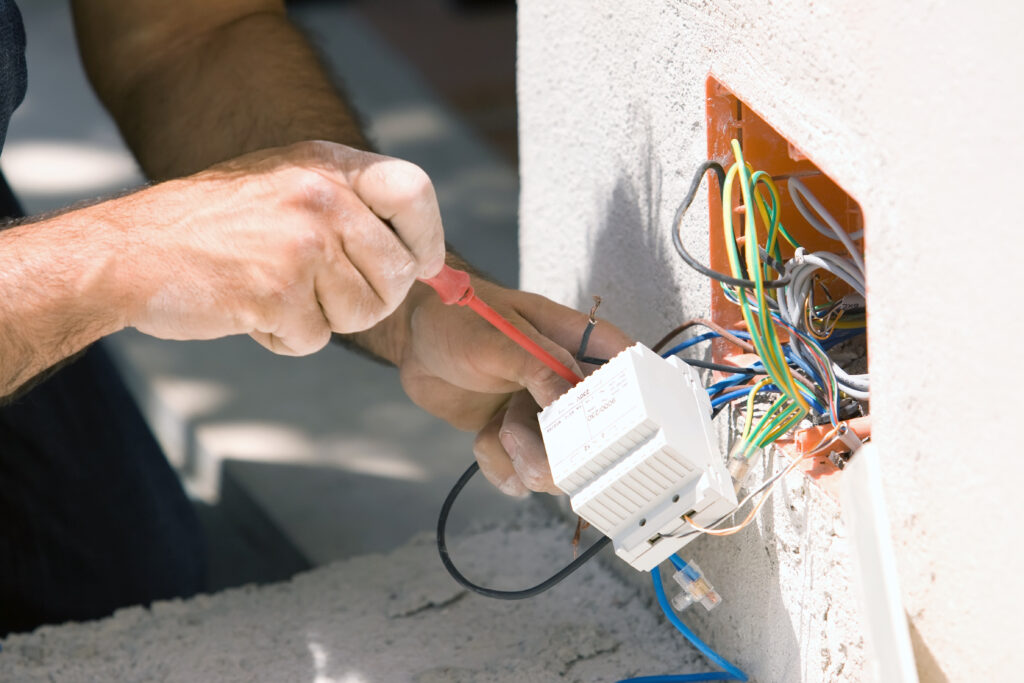
It’s not uncommon to notice a small spark when you plug something into the electrical outlet, especially if it’s a large appliance. This is simply because the metal prongs on your plug get close enough for the electricity in your walls to “bridge the gap.” However, there are some signs that you should watch out for that could mean potential electrical issues. Don’t hesitate to call our electrical contractors as soon as possible if you’re in need of electrical repair or assistance. To learn more about why outlets spark, keep reading.
Normal (Small) Sparks
Color: Blue
Duration: < 1 second
Size: < 5cm
The electricity in your home constantly runs along available circuits before returning to the main grid. However, when you plug something into the wall outlet, you may see a slight spark jump from the outlet to the plug.
While small sparks are normal from time to time, you should call a residential electrician if the problem persists.
An electric outlet that sparks all the time could be a sign of a larger problem, such as water damage or short circuits. In this scenario, we would need to evaluate the condition of your system before determining what electrical services are needed.
On the other hand, if you notice that the outlet doesn’t always spark but the item you plug in always causes a spark no matter the outlet, it could be a sign of poor wiring in a product.
Dangerous Sparks
Color: Orange
Duration: > 1 second
Size: > 5cm
If you’re noticing sparks that come off as orange, yellow, or red, these are warning signs to larger problems with your electrical system.
The reason for theses types of sparks may vary. It could be due to loose wiring, water/moisture damage, poor ground wire, worn-out circuits, outlets that are broken or damaged, or even a frayed wire in your walls.
Orange sparks should be taken seriously, as the Electrical Safety Foundation International reports that 51,000 electrical fires happen every single year.
If you notice signs of potential electrical problems, DO NOT try to solve it yourself. Electrical systems are incredibly powerful and tampering with it yourself could result in death. Only a trained electrician should ever work on your electrical systems, as they have the proper tools and knowledge to diagnose and handle electrical concerns.
When a Spark Is Due to Overloaded Circuits
Color: White
Duration: > 1 second
Size: very small, usually a bright flash
Your circuit breaker is designed to prevent circuits from overloading due to too much electricity. Circuit breakers are put in place to reduce your risk of fire.
When you plug too many things into a circuit (think of a wall in your home — one wall may run along a different circuit than another) it will trip the breaker because too much electricity is demanded. If that amount of electricity were to move through your wiring, it would melt and catch on fire. So, when you demand more electricity from a circuit than what is considered safe, the circuit breaker trips and automatically shuts off the power for your home. While this may seem like an inconvenience, the circuit breaker is doing you a great favor by preventing a fire.
Sometimes this process results in a spark. It’s usually a loud popping spark accompanied by a flash like someone just took a picture. These types of sparks are generally not a cause for concern, lest the outlet itself was fried in the process.
A fried or melted electrical outlet won’t work properly. Give us a call at (616) 987-0978 if this happens to you and we’ll be able to come out and get it replaced properly.
Another thing to watch out for is plugging in appliances. For example, the new fridge you installed in your finished basement could be overloading the circuit. If you have other things plugged in, it may be near-maximum capacity, resulting in the circuit breaker tripping at the addition of anything other than the fridge.
If a circuit is tripping immediately, with only one thing being plugged into it, it may be a greater electrical problem. This is another scenario where you’ll want to call the professionals because we can properly test your lines.
It’s important to understand that the electricity that powers your home carries heat. This means that too much electricity running through your system will eventually build up heat in the wall outlet, melting important insulation covering wires. Once electrical wires are exposed, you run the risk of burning down your house.
If you suspect you have a short-circuiting outlet, call our electrician as soon as possible, because we know how unsettling these types of concerns can be.
When Sparks Are Due to Age
If your house is getting old in years, you might want to have one of our residential electricians inspect your outlets. Over time, electrical outlets will eventually wear out and increase your risk of short circuits. Fortunately, our electrical contractors will be able to help you with replacing outlets so you can maintain a safe home.
We also highly recommend childproof outlets (also called tamper-resistant outlets) because they have spring-loaded cover plates that prevent a child from being able to stick an object into one of the receptacle’s contact points.
A tamper-resistant outlet looks and functions just like other outlets, except they protect children from electrical shock injury and are not a choking hazard like plastic covers can be.
Old homes (and new) tend to have a lot of dangerous outlets that, for whatever reason, kids and toddlers try to stick things like paper clips or forks into. To prevent your child from injuring themselves, make the smart investment of having child proof outlets installed. By no means will this guarantee electrical safety, but it can help.
Need Electrical Help?
Our Lowell electricians are able to inspect outlets and troubleshoot issues so you can avoid short circuits and other electrical problems. With any questions or to schedule a quote for replacing outlets, feel free to contact Flat River Electric online or by phone at (616) 987-0978.
[This blog post has been updated.]

